
The project comes to an end, so we start thinking of new beginnings…
The CoGhent project, which has now come to an end, aimed to convene citizen voices and perspectives in the digital transition of museums. By conducting user-research, the project sought out different thresholds and opportunities to figure out which data to open up and how to bring it together to give space and a voice to different cultural needs.
To end the project on a future looking note, NEXT-COGHENT embarked a selected group of stakeholders in a “design fiction” exercise to create possible future scenarios based on the themes that shaped the project. During this 3-hours workshop, the participants co-produced a series of medium-long term visual scenarios projected in a horizon of 15-20 years’ time and enabled by some of the tools and components developed during CoGhent project: What are the future visions that the CoGhent infrastructure and experimentations are enabling and suggesting? What could be done if all of Ghent’s digitised heritage is made accessible as linked data?
The challenge was to build upon the work which came out of CoGhent pushing it one step further to speculate on its integration in potential developments at a European and International level. It also gave space to a co-creative process between the different players of CoGhent - (re)mixing participation, heritage, and tech - to think about some of the future societal trends and their significance for the development of museums. The process allowed for a discussion around the potential issues that museums could face in a short to medium future.
Methodology, a walk into the future…
The workshop followed a four-step process in which the participants were stimulated through a set of materials that had been created appositely: speculative angles, building block components and scenario posters. The process went as follows: a team building exercise in which participants were presented different speculative angles outlining contrasted potential visions for the future of the project to discuss in sub-groups and intended as starters for scenario building; a sorting of resources produced by the CoGhent project presented as component cards for the various groups to combine to enable their scenarios; an emulation phase in which teams came up with and pitched their scenario vision. Lastly, teams matured their visions into more concrete scenarios to present to the rest of the group.
Stepping aside with speculative angles
When you’ve been working on a project for a long time it's hard to shift your point of view or perspective on it, sometimes you need to be pushed a bit to be able to see beyond your usual horizon. This is the purpose of the speculative angles: a set of cards that present different directions in which society, and in this case museums, could evolve. One can think of them as different divergences from the possible future graph, possible developments of the underlying trends and discontinuities that may happen. The four angles that were presented to the participants were: “fragmented society”, “museum remix”, “open culture incubator”, and “multicultural deliberation”.
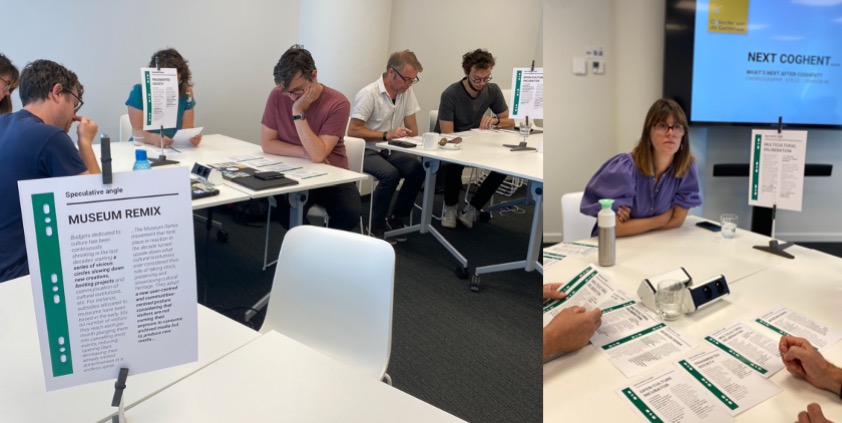
The four subgroups read through the speculative angles and discuss them between each other (photo credit: Strategic Design Scenarios).
How will the cultural fragmentation our societies are experiencing affect cohabitation between different communities in cities? How could the budgets allocated for cities to support services that regenerate a collaborative social fabric palliate this fragmentation? These are the food for thought introduced with the first speculative angle, “fragmented society”. In reaction, the subgroup of participants who chose that angle as starter thought about museum as a verb: not “a museum” but “to museum a place or a situation”. Museuming could then operate as a conversation starter in this fragmented society, establishing a museum to breed interaction between the multitude of cultures.
Alternatively, with the second speculative angle we can start imagining what museums would look like if individuals came there to produce rather than consume media. In this idea of a museum remix, another subgroup of participants started discussing the possibility of people coming to museums to create a sense of belonging.
The third angle questions what would happen if by opening their data to the public cultural institutions became incubators for creative start-ups. This sparked a vision of a collaborative open platform for cultural heritage supported by co-creative environments and funds.
Lastly, in the “multicultural deliberation” angle, society as a cultural melting pot is evoked with the blurring of references, origins, and identities. A scenario in which museums could become the place to celebrate this cadavre exquis of cultural identities.
By sparking the discussion, these speculative angles allow for some elements that were maybe implied in CoGhent to become explicit, or new visions to emerge which could carry the project beyond its initial finalities.
Using CoGhent components to come up with scenario visions
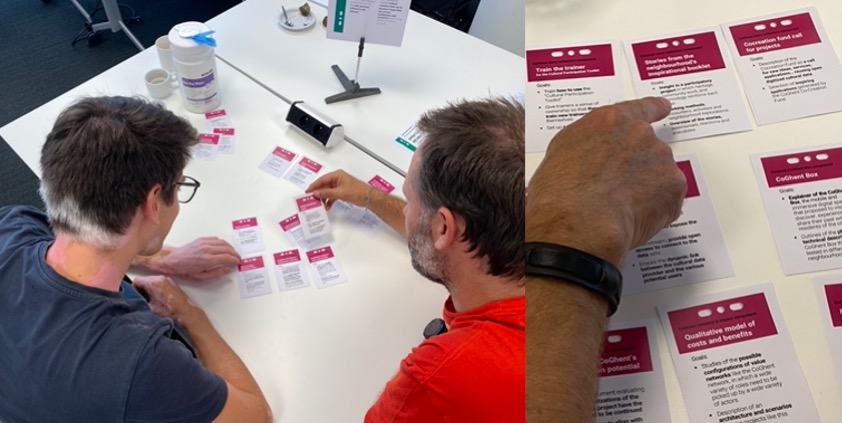
Here the participants look through the various CoGhent Components, clustering them in function of their selected speculative angle (photo credit: Strategic Design Scenarios).
After a very short time of speculative reflection, the 4 subgroups were asked to pitch their emerging visions for a peer review. This key confrontation with critical friends helped them to focus on the more robust and promising part of their vision in order to start the second step of the methodology, checking if and how CoGhent could help them realise it. The outcomes of the CoGhent project were presented as building blocks in the format of cards in which each component was summarised and organised in 5 main categories of outputs: How to involve the city populations in a story collection process? Which technical components to work with digitised cultural data? What are the first cultural objects open for creative reuse? What does the CoGhent Box first instantiation of the project interface consist of? What are the lessons learned from this innovation research project so far? In this phase, the participants were invited to read and select the components they found interesting and use them as building blocks for the first vision that emerged from the speculative angle they were working with.
This second step of the methodology worked as a first “reality check” forcing the subgroups to align their vision with what the CoGhent project enabled and make sure that they could effectively develop a follow-up scenario to the project.

Scenarios and proposals start to take shape as participants put pen to paper and start writing down their visions (photo credit: Strategic Design Scenarios).
Landing from blue-sky visions into actionable scenarios
The next and final step of the workshop involved transforming the visions into more tangible future scenarios with the support of a four-section scenario poster.
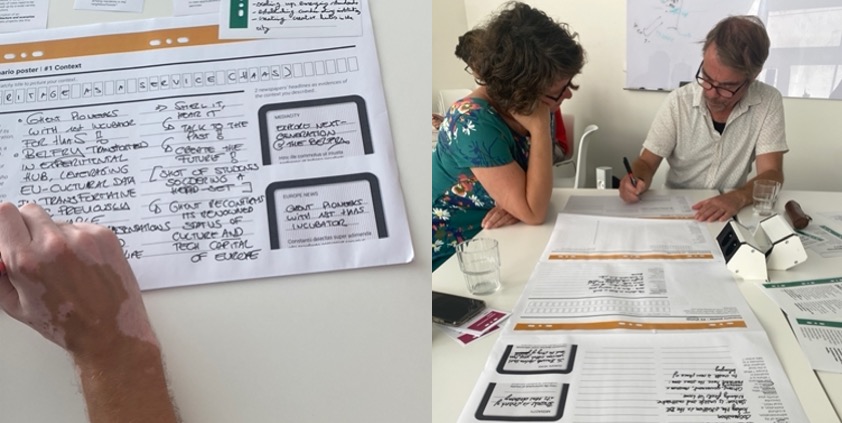
The groups go through each section of the scenario section, discussing and completing their idea as they go (photo credit: Strategic Design Scenarios).
Grasping the starting context, attracting the reader with a catchy title… the idea of the first section was to set the scene for the scenario each group would come up with and develop their vision by placing it in a fictional context they defined. Prompts such as headlines from fictional media outlets like Europe News or Mediacity were given to help embody the vision at different levels of governance.
In the second vision section, another prompt pushed participants to visualise their scenarios even further by asking them to imagine what the footage would be if their project was filmed for a short TV reportage on national TV. This envisioning process allowed to outline the scenario with post-produced visualizations that are presented in the following result part of the article. In the next section of the poster, participants were brought back down to a slightly more practical version of reality as they were asked to explicit the rationale behind their scenario with a budget or timeline. Lastly, each group had to outline the benefits of their idea, backed up with tangible evidences that could support these.
The idea behind these different parts of the scenario posters was to push participants to think of their proposal in concrete terms and develop it consequently.
Results: four scenarios and propositions for the future of museums
Now, let’s jump into the future of participatory or community-based museum our four subgroups imagined for us.
“When you want to catch a train, you can also catch some heritage. When you leave your luggage, you can also leave a piece of culture” poetically says David describing the station museum.
Cultural passages and exchanges at the train station.
“Brussels station becomes BXL museum” develops a vision that places itself in Brussels south station, transforming it into a bottom-up museum of tomorrow. Here the museum is shifted into a museum court, likening the concept to the one of a multicultural food market, a place of encounters, passing by, gatherings, and sharing. Here the museum is open to culture in the larger sense of the term, it is a place to which people can bring a piece of their food or music, just as they can eat, listen or see a piece of somebody else's culture.

Cultural passages and exchanges at the train station. In Brussels South station as people in transit wait for their correspondence they can discover the breadth of different cultures of people who have passed there before them. They themselves can become part of the cultural fabric by adding the collection that fills the station (photo credit: Strategic Design Scenarios).
This station in particular is chosen because its current atmosphere being generally unsafe and the space unattractive, hence the museum could be a transformative initiative to foster collaboration and a new sense of belonging for people of the neighbourhood. The significance of a train station as a place of arrival and departure, of transitions and encounters, presents an apt metaphor for a museum as a place of multicultural deliberation.
Museum scouting for living culture
“Huis Van Alijn moves to BXL to collaborate with citizens” imagines that Ghent’s Museum of daily life would become a mobile institution and temporarily moves to Brussels’s multicultural neighbourhood of Matonge. The core idea in this scenario is to use cultural heritage as leverage to facilitate cohabitation between the mix of origins of the neighbourhood. The notion of reach is also core to the proposal, as the group discussed a shift from a ticket-based museum to a reach based one. Participants propose an interesting use of digital assets as a way to create social value by increasing the reach a museum or cultural institution can have.
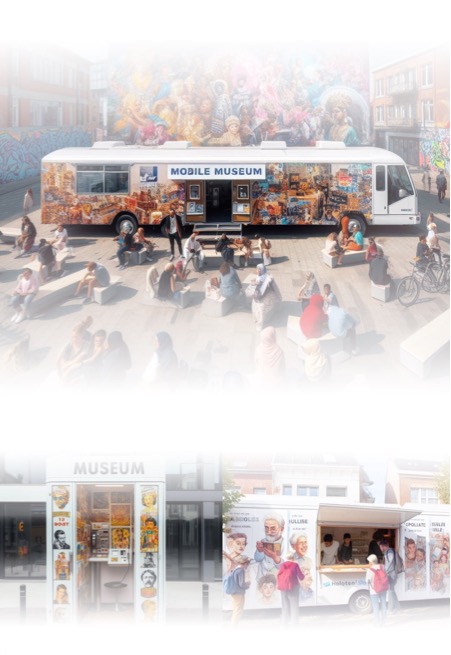
Museum scouting for living culture. The mobile museum settled in Matonge neighbourhood in Brussels to collect the rich neighbourhood cultural heritage. It has become a place for inhabitants to socialise, meet each other, learn from each other. It is a place of exchange and creation which is constantly changing and evolving as the population of the neighbourhood does. (photo credit: Strategic Design Scenarios).
The group emphasises the importance of good data and data cleaning before it is made public and “remixed”, ensuring a fluid process of appropriation of data by a wider public. This notion of “remixing cultures” is reminiscent of the “museum remix” speculative angle presented in the first part of the workshop, which the group interpreted as a future in which people in museums start combining things from their different backgrounds to build or create new localised cultures that remixes all the individual cultures of origin.
Belfries: the new beacons of culture
“Heritage as a service (Haas)” is much more imaginative than the title suggests. In this scenario, Ghent has reclaimed itself as the cultural capital of Europe by reimagining the use of the belfry, among other things. These historic landmarks become the symbol of an innovative museum scene by hosting state-of-the-art technology to become an experimental cultural hub. As hinted before, the participants in this group let their imagination run wild (enthusiastically adhering to the rules of fiction also in terms of budget) and equipped their belfry with holograms of historical figures, neon lights and interactive banners, soldering material for headsets, a time travelling cabin, and a historical re-enactment room.
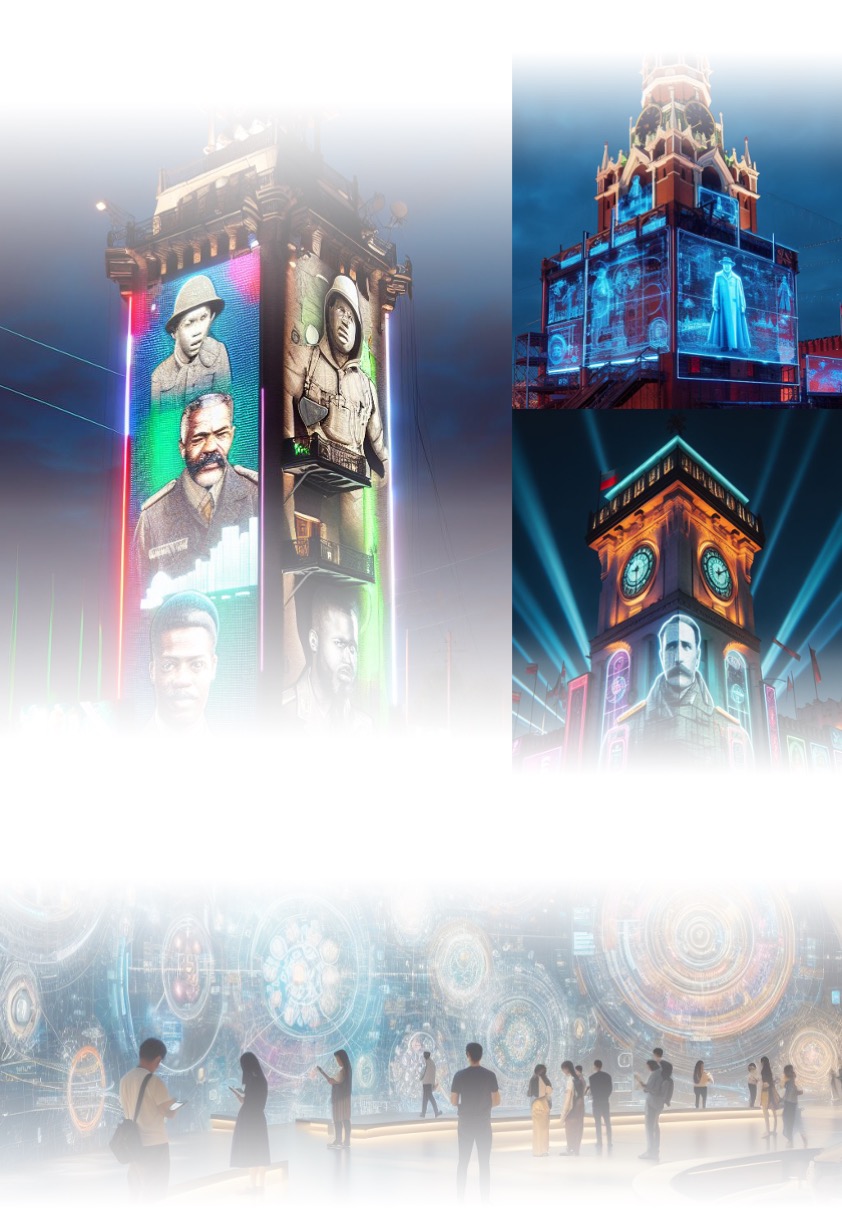
Belfries: the new beacons of culture. In Ghent you cannot be anything but drawn to museums, at night they illuminate the city with the state-of-the-art light displays emanating from the historic belfries. Here, museums have become synonym of technological advancement, students, tourists or inhabitants can immerse themselves in history with VR, tamper with a time machine, etc… (photo credit: Strategic Design Scenarios).
The group divides the building blocks which support their scenario into base assets (including CoGhent components such as the “75000 city museums and archive objects in digital format” and “data & copyright” guideline to manage them) and activation assets (including the “cocreation fund call for projects” or the “cultural data lab framework” as scenario enablers). These four elements are used by this group to explain the rationale of their proposal, connecting it with the work that they had taken part of with CoGhent. In their vision, the museum is a place where creativity happens, a place for people to become actors in their own heritage rather than mere spectators. Hence, institutions expand the range of their offer, providing both services and experiences to their public.
Culture in times of crisis
“The war is over! Let’s not forget” proposal focuses on a future in which the war in Ukraine is over. Here culture is associated with something that is needed in emergency situations, something that can have an impact or influence in these situations and in their aftermath. Museums, beyond places to remember the oppositions of the past and celebrate a present without fighting, become policy instruments to prevent geopolitical tensions or help to bring peace in open conflicts. The very strong intuition already mentioned of considering a museum as a verb pushes these ordinarily rather neutral institutions to become active vectors for resolution of intercultural and inter-territorial tensions.
“Maybe the city should consider to museum the growing communities’ conflict in this neighbourhood?”
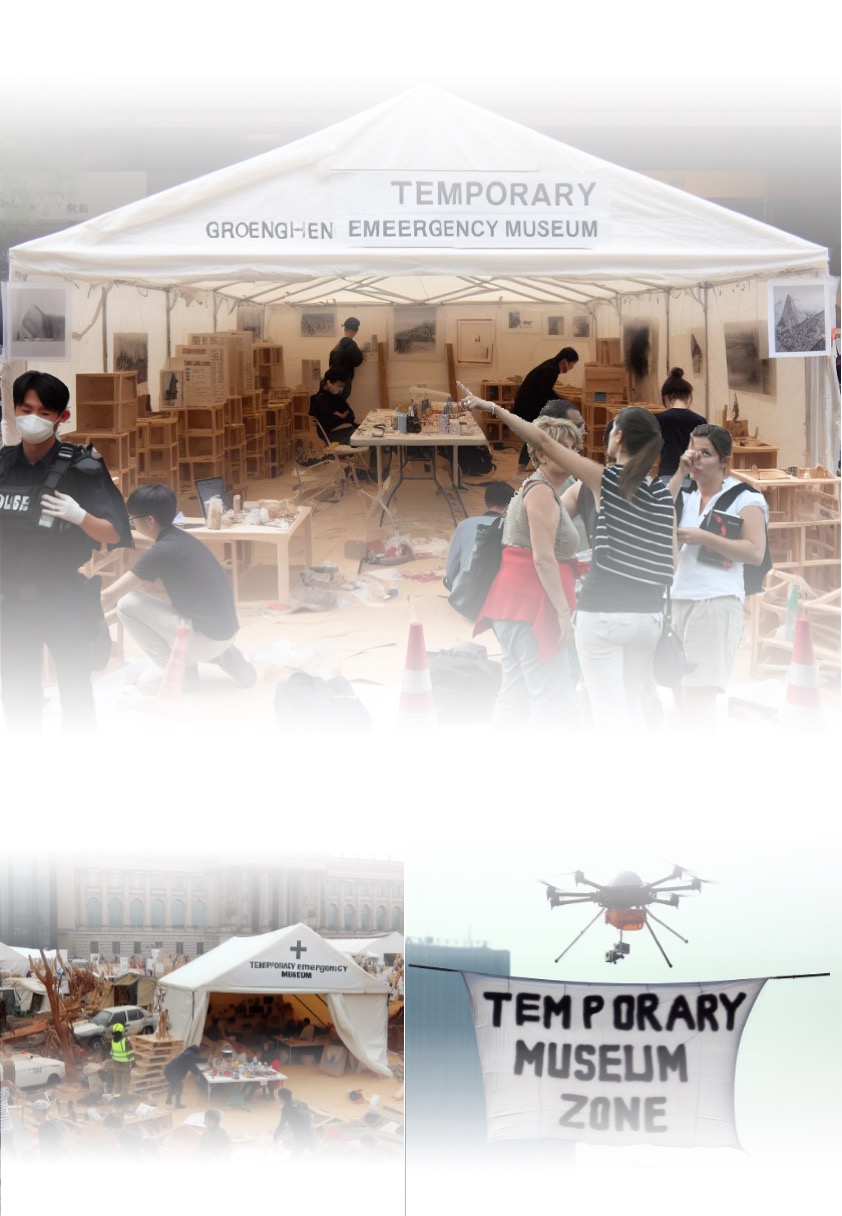
Culture in times of crisis. The temporary emergency museum settled yesterday in the neighbourhood Groenghen where tension is growing between the many communities living there. The inhabitants of this area of the city requested themselves to museum the neighbourhood and start right away the work of integration, strongly missing since the last 5 years massive arrival of new immigration waves… (photo credit: Strategic Design Scenarios).
In terms of reuse of the project components made available by CoGhent, these 4 scenarios seem to be mostly based on the category of modules to “involve the city populations in a story collection process” and the “first cultural objects open for creative reuse”. The category of “technical components to work with digitised cultural data” seems to be involved predominantly to store and manage digitised data. The category of “lessons learned from this innovation research project so far” is a transversal asset and the category focussing the “CoGhent Box first instantiation of the project interface” is not referred to.
Discussion: reinventing museums against their will?
In terms of content, Next CoGhent actually did explore the evolution of the role of museums with the opening up of data to the wider public, questioning how this digital shift can be done in a way to favour social cohesion. The workshop looked specifically at involving citizens in the digitisation processes, investigating how museums can also enlarge their current cultural representation to reflect the cultural diversity which now makes up the societal fabric of Ghent, and more widely all places in the world. “We missed the involvement of the museums in the workshop”declared Tomas De Preter from Studio Dott. Is that accidental or symptomatic? Paradoxically, Next CoGhent tends to reinvent museums in the absence of the CoGhent project’s stakeholders working in museums or cultural institutions. Participants felt that the scenario proposals reinvented could have benefited from the input or feedback from representatives of the institutions themselves.
For Line Ostyn, coordinator of CoGhent: “It’s difficult for museums to imagine themselves in completely different roles and goals” pointing towards new roles for museums invented by the participants. In the four scenario proposals, the museum has evolved past its traditional and current role revolving around conservation, cataloguing, preservation and archiving into more proactive and engaged institutions. This self-questioning and re-inventing in light of current societal trends and technological developments is something that museums seem to struggle with, often staying stuck on ideas of the past. As Pieter-Jan Pauwels from District 09 said: “Museums will not like our museum scenarios as they diverge from their goals”. This small-scale experimentation gave the freedom to push museums out of their comfort zone and reuse the outcome of the CoGhent project to re-imagine their purpose in an evolving society, with new ways of interacting, engaging and representing the public.
The workshop also teases the CoGhent workplan in methodological terms. “Such an exercise should have been organized at the beginning and the end of CoGhent” remarks Sofie Rottiers, community worker at the city of Ghent. The quality of ideas and debates sparked by the exercise led to discussions about integrating such processes at both ends of city innovation projects UIA is promoting. The participants agreed that the wealth of the discussions bred fertile ideas for the future but also could create beneficial debate around what the project should focus on and shed light on some potential issues or threats that could arise in it.
It’s a way to “translate the insights of evaluation of the project into something tangible in the future…” comments Bas Baccarne from University of Ghent. The exercise was appreciated as a way to allow the various participants to have a moment of reflection, think about the lessons learned during CoGhent, and how they could be applied in the eventuality of a new iteration of the project.
PARTICIPANTS
Bas Baccarne , Jeroen Budts, Jan Van Cauwenberge, Pieter Van Kerkhove, Line Ostyn, Pieter-Jan Pauwels, Tomas de Preter, Sofie Rottier, David Slosse, Ariana Tabaku
About this resource
The Urban Innovative Actions (UIA) is a European Union initiative that provided funding to urban areas across Europe to test new and unproven solutions to urban challenges. The initiative had a total ERDF budget of €372 million for 2014-2020.
Similar content




